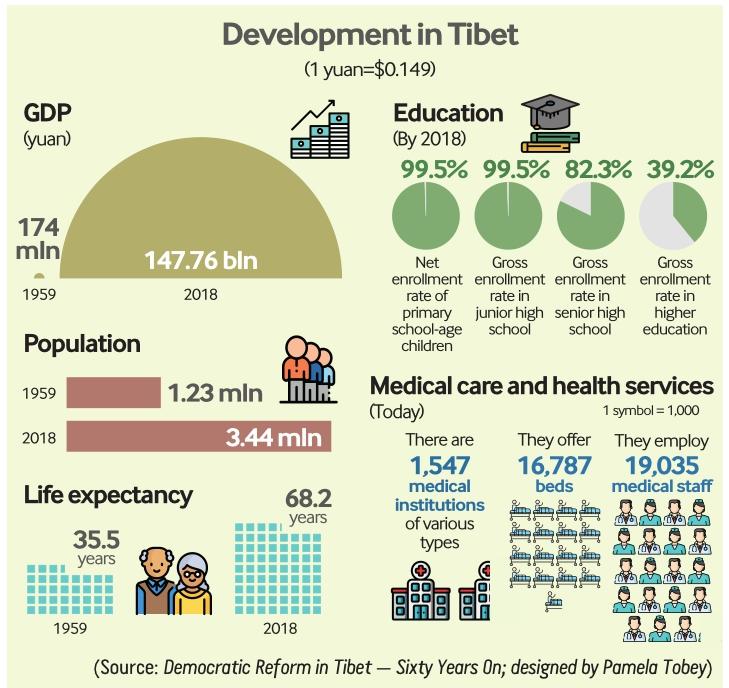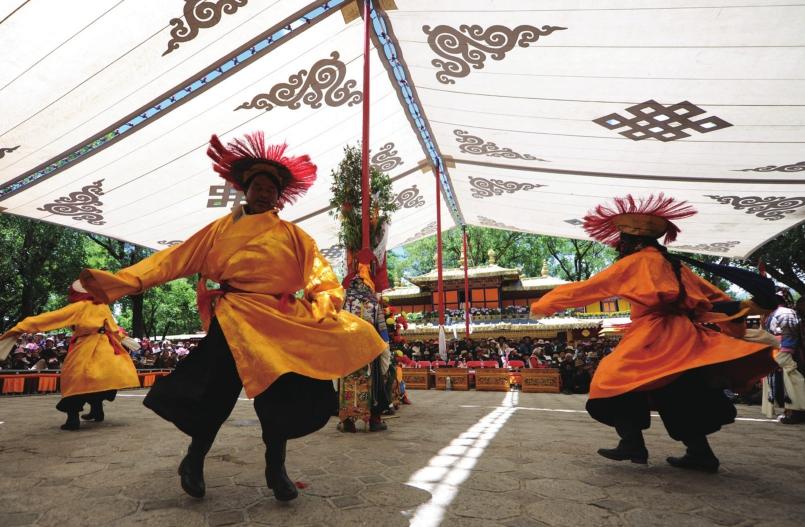LIFTING UP THE PEOPLE
2019-04-15ByYuanYuan
By Yuan Yuan


A white paper on democratic reform and the development leap that has taken place in southwest Chinas Tibet as a result was issued by Chinas State Council Information Office on March 27, marking the 60th anniversary of the campaign in Tibet.
Titled Democratic Reform in Tibet—Sixty Years On, the white paper lauded the drive as “the greatest and most profound social transformation in the history of Tibet.”
“By abolishing serfdom, a grim and backward feudal system, Tibet was able to establish a new social system that liberated the people and made them the masters of the nation and society, thus ensuring their rights in all matters,” the document stated.
Dramatic changes
Tibet has changed completely, with the region becoming a beautiful home for the local people and their solidarity and enterprising spirit growing. Through democratic reform, feudal serfdom under a theocratic system was completely abolished, with some 1 million serfs liberated, said the white paper.
Tibets impressive development fully demonstrates that its democratic reform conformed to the historical trend of the times and the fundamental aspirations of all ethnic groups in Tibet and met the peoples real demand for social progress.
The white paper discussed the First Session of the First Peoples Congress of Tibet, which was held on September 1-9, 1965. At the session, Tibet Autonomous Region was established and the peoples committee of the autonomous region was elected.
“A large number of liberated serfs held leading posts in organs of political power at various levels of the Region. The establishment of the Tibet Autonomous Region and the organs of self-government of the region realized the historic leap from theocratic feudal serfdom to peoples democratic socialism, and signified that Tibet had set up a peoples democratic government and begun to exercise thorough-going regional ethnic autonomy,” the white paper said.
The people in Tibet can, in accordance with the law, directly elect deputies to the peoples congresses at the county and township level. These elected deputies then elect deputies to the peoples congresses at the autonomous regional and national level.
Currently, there are 35,963 deputies to peoples congresses at all levels in Tibet. Among them, deputies from Tibetan and other minority ethnic groups account for 92.18 percent, according to the document.
Women have also been empowered with political rights over the past 60 years. They took an active part in political affairs by participating in elections, serving as leading officials at various levels and establishing womens organizations.
In addition, democratic reform in Tibet has greatly improved the productive forces. According to the white paper, democratic reform enabled former serfs to own their land, farm tools, cattle and other means of production. They showed ever growing passion for working hard to create wealth, with agriculture and animal husbandry significantly progressing.

Since 2013, more than 273,000 new urban jobs have been created. In 2018, the registered urban unemployment rate was 2.83 percent.
In 2018, the autonomous regions GDP was 147.76 billion yuan ($22 billion), soaring from the 1959 figure of 174 million yuan ($25.9 million). The average per-capita disposable income of urban residents was 33,797 yuan ($5,036), and that of rural residents was 11,450 yuan ($1,700).
Tibets infrastructure has been greatly enhanced. Before liberation in 1951, it had no proper highways; but today, it has a comprehensive transport network composed of highways, railways and air routes. By the end of 2018, Tibet had 97,800 km of highway, including 660 km of high-grade highways, with all counties in Tibet having access to highways.
Modern industry started from scratch and has grown steadily. Tibet now has a modern industrial system covering over 20 sectors. Agriculture and animal husbandry are no longer subject to nature and the environment and are being consistently modernized.
Tertiary industry is thriving too, while tourism is rapidly developing. In 2018, Tibet received 33.69 million tourist visits, with total tourism revenue hitting 49.01 billion yuan ($7.3 billion). More than 100,000 farmers and herdsmen have increased their income through tourism as Tibet becomes an international tourist destination.
Better living
Before 1959, education was largely the domain of the privileged aristocracy. The serfs, who made up 90 percent of the population, were not entitled to education, resulting in an illiteracy rate surpassing 95 percent among young people.
Figures from the document showed that in 2018, the net enrollment rate in primary schools in Tibet was 99.5 percent, while gross enrollment rates in junior high, senior high and higher education were 99.5, 82.3 and 39.2 percent, respectively, with the percapita length of education reaching 9.55 years in the region.
“After democratic reform, Tibet put an end to the theocracy, separating the government from religion and thus restoring the latters true significance,” the document said.
Currently, Tibet has 1,787 sites for the practice of Tibetan Buddhism, over 46,000 resident monks and nuns, and 358 living Buddhas. There are four mosques and over 12,000 native Muslims, and one Catholic church and 700 believers, according to the white paper.
The living Buddha reincarnation is a succession system unique to Tibetan Buddhism, and is respected by the state and governments at different levels of the autonomous region.

By 2018, the document said, 91 incarnated living Buddhas had been confirmed through traditional religious rituals and historical conventions. Since the 1980s, more than 1.4 billion yuan ($208.5 million) has been spent on restoring Tibetan cultural relics and refurbishing key monasteries.
Over the past 60 years, Tibet has made steady progress in medical and health services, with a system featuring traditional Chinese medicine, Western medicine and Tibetan medicine now in place.
Moreover, the Tibetan language is protected by law and has developed smoothly. The excellent traditional ethnic culture has been carried forward and promoted through a number of laws, regulations and official documents, providing a legal basis for the protection of Tibets ethnic culture.
Significant progress has been made in protecting cultural relics as well. Tibetan Culture Week and the China Tibet Tourism and Culture Expo are becoming platforms to present traditional culture to the world. Tibet has also sent a variety of art troupes to over 100 countries and regions to perform, put on exhibitions and carry out academic exchanges.
In view of the current economic and social climate, Tibet is committed to coordinated and sustainable development. It firmly believes that lucid waters and lush mountains are invaluable assets, and that ecological protection is also a means of protecting the productive forces. Bearing these ideas in mind, it prioritizes green development with ecological protection.
“Following the Belt and Road Initiative, the government of Tibet is building a policy structure that is inclusive, open, and cooperative in nature, while accelerating opening up,” the white paper said.
It also noted that Tibet works hard to enhance a sense of participation and gain for people of all ethnic groups to ensure that the fruits of development are shared by all the people in the region.
